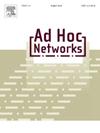A systematic literature review on spectrum detection for Cognitive Radio-Internet of Things networks
IF 4.4
3区 计算机科学
Q1 COMPUTER SCIENCE, INFORMATION SYSTEMS
引用次数: 0
Abstract
The exponential growth of Internet of Things (IoT) devices has created a huge demand for Radio Frequency (RF) spectrum, only exacerbating the current congestion and shortage situation. This is where Cognitive Radio-Internet of Things (CR-IoT) systems come into play, which promises to bring in the functionality of dynamically managing spectrum resources to provide better spectral efficiency by recognizing and exploiting unused frequency bands, or spectrum holes. This systematic literature review investigates the integration of Cognitive Radio (CR) functionalities within IoT networks, focusing particularly on spectrum sensing techniques. Whereas conventional approaches rely on spectrum usage measurements in the frequency domain, temporal slots detection addresses a scarcely touched asset, i.e., predicting spectrum availability over time. Through an analysis of the literature, this paper brings out the advantages of integrating CR into IoT networks and reviews the prominent spectrum sensing techniques in CR-IoT scenarios. Moreover, by addressing the current research gaps in the review, especially from a temporal-aligned spectrum sensing perspective, we particularly highlight the gap of the limited attention to temporal spectrum sensing and suggests future directions for optimizing both frequency and temporal spectrum prediction to improve CR-IoT network performance.
认知无线电-物联网网络频谱检测的系统文献综述
物联网(IoT)设备的指数级增长创造了对射频(RF)频谱的巨大需求,只会加剧当前的拥堵和短缺情况。这就是认知无线电物联网(CR-IoT)系统发挥作用的地方,它有望引入动态管理频谱资源的功能,通过识别和利用未使用的频段或频谱漏洞来提供更好的频谱效率。本系统的文献综述研究了物联网网络中认知无线电(CR)功能的集成,特别关注频谱感知技术。传统的方法依赖于频域中的频谱使用测量,而时间间隙检测解决了几乎不涉及的资产,即预测频谱随时间的可用性。本文通过对文献的分析,揭示了CR与物联网网络融合的优势,并对CR-IoT场景中突出的频谱感知技术进行了综述。此外,通过解决综述中目前的研究空白,特别是从时间对准频谱感知的角度,我们特别强调了对时间频谱感知关注有限的空白,并提出了优化频率和时间频谱预测以提高CR-IoT网络性能的未来方向。
本文章由计算机程序翻译,如有差异,请以英文原文为准。
求助全文
约1分钟内获得全文
求助全文
来源期刊

Ad Hoc Networks
工程技术-电信学
CiteScore
10.20
自引率
4.20%
发文量
131
审稿时长
4.8 months
期刊介绍:
The Ad Hoc Networks is an international and archival journal providing a publication vehicle for complete coverage of all topics of interest to those involved in ad hoc and sensor networking areas. The Ad Hoc Networks considers original, high quality and unpublished contributions addressing all aspects of ad hoc and sensor networks. Specific areas of interest include, but are not limited to:
Mobile and Wireless Ad Hoc Networks
Sensor Networks
Wireless Local and Personal Area Networks
Home Networks
Ad Hoc Networks of Autonomous Intelligent Systems
Novel Architectures for Ad Hoc and Sensor Networks
Self-organizing Network Architectures and Protocols
Transport Layer Protocols
Routing protocols (unicast, multicast, geocast, etc.)
Media Access Control Techniques
Error Control Schemes
Power-Aware, Low-Power and Energy-Efficient Designs
Synchronization and Scheduling Issues
Mobility Management
Mobility-Tolerant Communication Protocols
Location Tracking and Location-based Services
Resource and Information Management
Security and Fault-Tolerance Issues
Hardware and Software Platforms, Systems, and Testbeds
Experimental and Prototype Results
Quality-of-Service Issues
Cross-Layer Interactions
Scalability Issues
Performance Analysis and Simulation of Protocols.
 求助内容:
求助内容: 应助结果提醒方式:
应助结果提醒方式:


